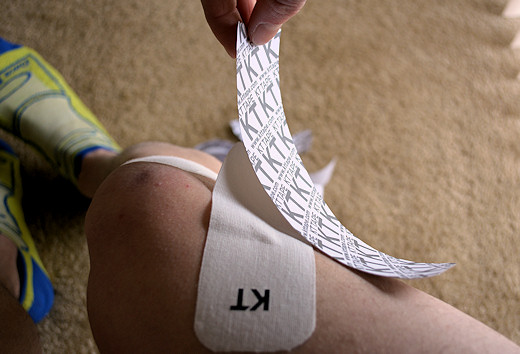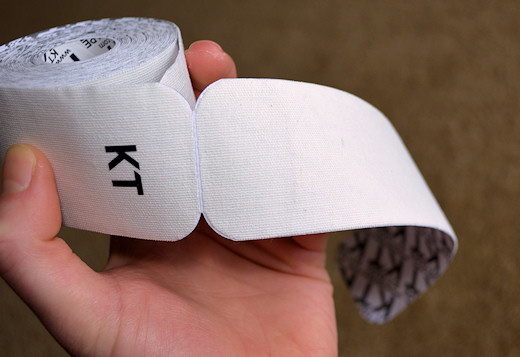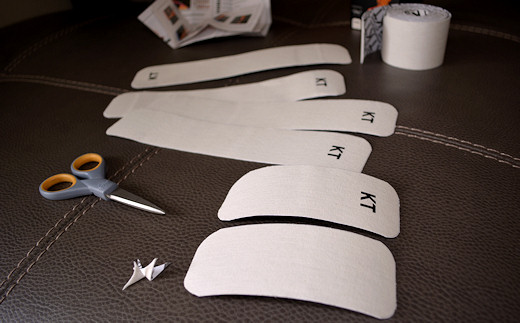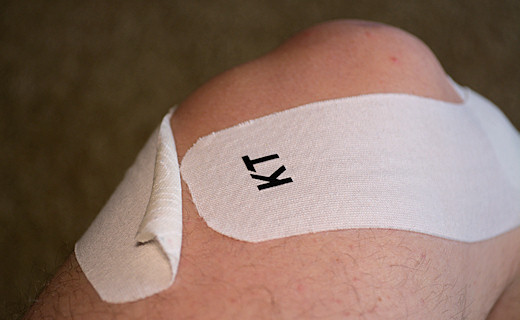
Unless you’ve been living under a rock, you’ve probably heard about kinesiology tape. You’ve probably seen many pro athletes using it. I wouldn’t be surprised if you’ve used it yourself.
There are quite a few brands out there now, but KT Tape is probably the most popular kinesio tape among athletes.
This is the one endorsed by Olympic gold medalist Kerri Walsh. She calls it “ridiculously wonderful.”
What does it do that makes it so wonderful? Let’s discuss…
Table of Contents
Why Kinesiology Tape
It’s not for style points. People use kinesiology tapes to:
- relieve pain
- provide support
- enhance performance
It almost sounds too good to be true.
If you’ve used athletic tape in the past, you might be skeptical. You might be thinking kinesiology tape is the same thing. Not even close!
How does kinesiology tape work?
I’m not a doctor, so I can’t explain exactly how kinesiology tape works. My understanding is that the tape provides a gentle support for the skin surrounding your muscles, which increases your awareness of those muscles, which then makes your muscles and joints feel supported, even thought the thin tape does not look like something capable of supporting you!
You won’t find a lot of scientific studies to support the validity of this tape, and for all I know, it could all be a placebo effect! But I find it very intriguing.
Why people tape with KT Tape
Depending on who you ask, this tape can do just about anything. Any type of pain or soreness or injury, there’s a way to treat it with kinesiology tape.
A good way to think of it is as a supplement to your chiropractic visits. Much like brushing and flossing when you’re not at the dentist, taping an injury can help you make the most of each chiropractic adjustment.
Where I see the biggest benefit is that this tape stabilizes muscles and joints without restricting your range of motion. The lightweight support is perfect for minor injuries when you don’t want to wear a bulky knee or elbow brace. That sort of brace is going to be uncomfortable and will likely to hinder your mobility if you’re returning to action. If you tape the affected area instead, you can likely still participate in your sport as you normally would.
Similarly, if you have an injury-prone area, you could tape up with the goal of injury prevention. (No guarantees here, but it usually doesn’t hurt.)
You can also use it to reduce chronic pain. Perhaps your lower back bothers you occasionally. Or there are lingering issues, perhaps from a previous injury that didn’t heal very well. A core strengthening program would be ideal, but that takes time. Tape yourself up and get some instant pain relief.
There are even techniques for using the tape to help drain lymphatic fluid from an area to decrease bruising and swelling.
You won’t find many research studies on this tape, especially not when it comes to using it to improve athletic performance. But I use it for injury rehab and muscle support, and in that case, all you have to do is try it once and you won’t care about what any studies say anyway.
How to tape with KT Tape
Say you buy a roll of this tape. How do you know what to do?
Well, if you know a sports medicine professional who can show you, that would be best. Maybe your chiropractor uses it and will tape you up.
On your own? Not to worry. The company provides instructions on the website for virtually every application. Everything from your toes to your neck, and literally everything in between (like your abdominals).
The videos are even in HD, like this:
The videos from KT Tape are excellent quality, use better camera angles, and are overall more useful than the videos I found on the RockTape website.
This video shows how to measure/estimate the stretch of the tape:
Getting the right stretch is critical, so pay close attention!
If you watch enough of the videos and keep practicing, you should be able to get the basics down. But to be clear, that’s just so you can do some basic taping on yourself. People go to entire seminars just to learn how to apply kinesiology tape! Don’t expect to be good at this on your first try!
Testing The KT Tape Kinesiology Tape
I’m often injured from one of my adventures, so I’ve been testing KT Tape in a variety of situations.
Taping up my knees
I received a sample of the original KT Tape to test.
At the beginning of the year, I spent some time nursing injuries that popped up and kept me sedentary, so I lost some strength in the muscles around my knees. At my age, I can’t just jump back into intense training, but sometimes I do anyway. Which is why I use this tape!
I’m looking at a triathlon in August and need to train, but my knees are in bad shape, so I need to tape them up frequently in order to do the workouts I need to do to strengthen them.

Your knee is going to be one of the more difficult joints to tape! But I followed their instructions and did alright. And once the tape was on, it was wonderful!
Update: Since I first did this review, they released a new product called Flex Adhesive Strips. This is a knee-specific tape which contains a flexible stabilizing bar embedded in the tape for added support and stability. You place the strips on either side of the knee as an alternative to a bulky knee brace. I’ll have a review posted soon.
Taping for shin splints
I also taped for shin splints. Not shin splints the serious injury, just the minor shin pain when running.
I used to have serious problems with shin splints, but that was because I took some bad advice and started using super big, motion control running shoes. Now it’s infrequent, but if I go a long time without running, I get minor shin pain during runs (especially on pavement.)
I’m transitioning from cross country skiing to trail running right now, so these early runs are going to be tough on the legs. (Skiing was virtually no impact!)
Taping a flat surface in a straight line was fairly simple, but harder than I expected it to be, actually.
But, once the strips were applied, my shin felt awesome! I had a really good feeling about running!
The pre-cut strips are a remarkable idea
The first thing I did was ask myself, “is it any more convenient to get 20 pre-cut strips?”
The answer – you better believe it!!

I was skeptical at first. Since you still have to cut the pre-cut strips sometimes, I didn’t think it would make much difference. But I was so wrong!
I realized it the very first time I used it. I needed 5 strips for my knees – 4 full strips, and two 1/2 strips. Getting the 5 strips was easier than ripping 5 pieces of toilet paper!
It makes the job so neat and tidy. I really do like the convenience!
I only had to make three cuts, and only had this tiny bit of waste:

I guess on the downside, the full-length strips were about 2″ too long, and that adds up to a lot of extra tape used without reason.
Otherwise, I love the pre-cut strips!
KT Tape Test Results
Here’s how my KT Tape testing went.
How did it work?
There’s definitely a different feel to this original stuff. It feels thin and cheap, like a worn out cotton t-shirt. As you work with it, you have to be careful. I kept thinking it would rip, or that it wouldn’t spring back to shape, since it’s not nearly as stretchy.
Compared to the synthetic stuff, it barely stretches! Maybe half as much.
However, while the synthetic tapes might be better to work with, once the cotton tape was applied, it functioned exactly as it was supposed to!
Less pain? Check.
More stability? Check.
Once my knees were taped, and I stood up to walk around, I experienced that same magical effect as I’m used to getting with Rock Tape.
That’s the good news. The bad news is, this stuff is just as touchy/picky/stubborn as RockTape. If it touches one stray leg hair, it’s going to peel right off your leg. So take the same precautions: perfectly smooth, clean skin is required.

On the flip side, whenever I taped areas that were perfectly clean and smooth, the original tape would stick much longer than advertised!
So be sure to remove body hair before taping, for best results.
I’m thoroughly impressed with how long this will stick. If I taped properly it lasted far more than 1-3 days. Even on my knee, I once got it to stay put for 7 days! (It probably does lose a little supporting ability after that 3 day mark though.)
On my shin, the tape still looked brand new after the 3 day mark!
Speaking of my shin, how did the running go?

The runs went well – too well!
First I went for a trail run and experienced absolutely no shin pain. That was both good and bad, because I was trying to cause the pain!
Undeterred, I went out two days later and did a few hilly miles on the pavement.
Again, there was no shin pain!
I could feel the shock in my quads and glutes, and my calves were a little tight after, but my shins weren’t phased.
Either my running form has improved, my brand new Feetures socks are magical, or the tape works in such a way that applying it to your left leg simultaneously eases the pain in your right leg!
KT Tape Original vs KT Tape Pro vs RockTape
In this review you saw me using the KT Tape Original. It’s the budget tape that retails for $12.99 per roll.
It’s made of cotton, provides good support, and is supposed to last for 1-3 days.
They also make a synthetic version called KT Tape Pro, the fancy stuff which retails for $19.99 per roll.
It’s a special synthetic material which provides better support, lasts 4-7 days, and is waterproof. There are even reflective elements in the tape for added visibility.
If you’re an athlete, it seems like the obvious choice.
As an added bonus, the pro version comes in a permanent carrying case, not just a cardboard box. That’s a nice touch because you don’t want to damage the tape or have it unroll out of control.
Then there is a competing product called RockTape. It is similar in features and in price ($20.00 per roll) to KT Tape Pro.
The only differences that stand out are that RockTape doesn’t include a plastic carrying case, and the tape doesn’t have reflective strips in the fabric. Neither of those are deal breakers, though.
Deciding between KT Tape Pro and RockTape is mainly a matter of personal preference. (For me, RockTape always sticks better.)
Which tape is best?
If you’re just getting started and practicing your technique, the original KT Tape is fine. You’ll probably waste some as you learn, so you might as well waste the cheaper cotton tapes.
But after your first roll, if you decide to keep using it, you will probably want to upgrade to the synthetic tapes, whether it be KT Tape Pro or RockTape.
The synthetic material is just so much better. If you’re a swimmer or triathlete, it’s critical. Cotton tape won’t even last through a single workout in the water.

The only other situation where you may want to choose cotton tape is if you develop skin irritation. Cotton tapes may be better for sensitive skin. They’re also easier on your skin since they don’t stick on nearly as long.
My final verdict is…
I’m a huge fan of kinesiology tape, and this KT Tape is no exception. The original cotton tape is inferior to the good synthetic stuff, but if you’re not going to get in the pool, the actual results are pretty darn close.
I like to keep both tapes on hand. If I’ll be in the pool, KT Tape Pro. If I’m taping a joint like my knee, KT Tape Pro. But if I’m doing a simple tape job on my foot, shin, or back, I’ll just use the Original.
Official website: www.KTTape.com
Buy online: www.Amazon.com
Company: KT Tape
Product: KT Tape Original
Reviewed by: Coach Levi
My Rating: out of 5
Date last updated: 2015-04-04
Obtained Product: Free sample from company.
CoachLevi.com Advertiser: No.
Click here if you would like to get your product reviewed on CoachLevi.com.
Levi Bloom is an experienced endurance athlete who has been training and competing for over 17 years. A former Cat 1 road and mountain bike racer (professional class on the regional circuit), he is now a cycling coach (USA Cycling Level 3 Certified) and sports nutrition coach (Precision Nutrition Level 1 Certified).



Hi Coach,
Just wondering if you’d been able to test Rocktape H2o?
@Steven
Not yet, but since I’m a huge fan of the original RockTape, I have high hopes for the H2O line!
As we approach winter and I get in the pool, I should get some Rocktape H2O for testing.